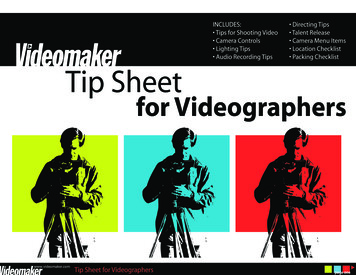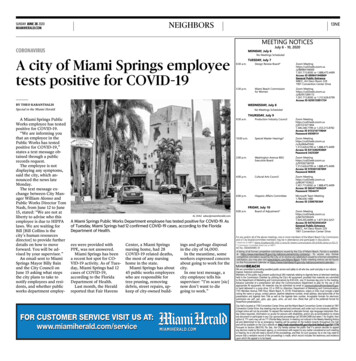
Transcription
Includes: Tips for Shooting Video Camera Controls Lighting Tips Audio Recording Tips Directing Tips Talent Release Camera Menu Items Location Checklist Packing ChecklistTip Sheetfor Videographerswww.videomaker.comTip Sheet for Videographerspage one
Tips for Shooting VideoShooting Basics To get the sharpest focus, zoom into subject’s eyes,focus, and zoom out to compose the shot. Record at least 30 seconds at the beginning of a newtape before shooting your footage. Shoot pre-roll and post-roll with an extra 5 secondsbefore and after each shot. Keep the camcorder handy with blank tape andbatteries charged. Set white balance at every location. Keep the shot steady (do not overuse zoom or pan.) Use a tripod or other camcorder stabilization. For handheld stability, imagine that your camcorder isa very full cup of hot coffee. Check the audio with headphones to make sure it’sbeing recorded properly to the camcorder. Use manual focus if your camcorder has it. Keep your average shot length between 5 and 10 seconds. When shooting handheld, wide shots will appear lessshaky than zoomed in shots. Try to keep a log of what is on each tape. Not so muchthat it is a burden, but more than you can fit on a label.For more information on Shooting Basics,visit this article, Home Video Hints: CommonShooting Mistakes.Composition Avoid telephone poles and other objects that canappear to stick out from the back of the subject’s head. When shooting outdoors, keep the sun behind you. Give the subject proper head and looking room. Use Zoom in to compose your shot, but avoid zoomingwhile the tape is rolling. Move the camcorder only when necessary. Use the rule of thirds when composing shots, unlessyou have a good reason not to. Be conscious of tilted shots. Level your camcorder usingobvious horizontal planes (horizon lines, desks or buildings.) Be careful of shooting a subject in front of a window orother bright sources.Shooting on the fly While shooting, be as inconspicuous as possible to bestcapture the true behavior of your subject. Be aware of soft spoken subjects.For more information on Compostion, visit these articlesComposition 101: Part 1.Composition 102: Part 2.Setting up a scripted scene Consult the storyboard and/or script. Time the number of spoken words at about 3 per second. Check battery power. White balance. Sound check. Light check. Tape check. Tripod lock-down. Time/date stamp on/off. Image stabilization on/off. Zoom in/Focus/Zoom out. Compose image. Rehearse. Reference Take 1, 2, etc (held right in front of the lens.) Shoot! Log takes.For more information on Scripted Scenes, visit thisarticle Shooting for the Final Edit.www.videomaker.comTip Sheet for Videographerspage two
Camera Controls Auto focus: Use for uncontrolled action(i.e. soccer game, parade). Manual focus: Use for controlled situations,(i.e. interviews, narrative scriptive shooting). Auto push focus: This button will override to auto focuswhen pushed. On release it will resume manual focus. Exposure: The exposure encompasses the tools thatcontrol light levels. (i.e. shutter speed, f-stop, gain). White balance: Sets the proper color balance. Place awhite object at the shot site and “set“ the whitebalance button. ND filter: Cuts down the intensity of light, but doesn’taffect the color. Zebra stripes: A tool that displays diagonal lines toshow areas of the image that are too bright. Stripes donot show up on tape. Can be set to different IRE levels(i.e. 70, 80, 100). Shutter speed: Higher speeds limit light, (i.e. 1/8000)but make fast action shots more clear. Slow speedsincrease light, but will blur action shots. F-stop: Low number opens the iris (allows formore light, higher number closes the iris (less light.) Gain: To brighten image use gain only after maxingF-stop and shutter speed. Gaining makes a grainierimage, especially past 6 dB.For more information on Camera Controls, visit thisarticle, Buttons and Menus and Dials, Oh My!www.videomaker.comTip Sheet for VideographersLighting Tips Remember video doesn’t handle extremes in contrast well.Limit the brightest and darkest areas of your composition. Monitor your lighting setup with a professionalmonitor or good TV. Bouncing light using white cards orreflectors (foldable flex discs) canfill in shadows and reducecontrast. Bring extra lamps (bulbs.) Soft light will help hidewrinkles. Hard light can give dramaticresults. Lights get hot. Make sure tobring some gloves to handleyour lights. Gold side reflectors cast a warmlight that is complimentary toflesh tones. Silver side reflectors give a highercontrast. White side reflectors are lower in contrast. Diffusion material creates softer shadows. Double diffusion material to increaseits effect. Diffusion material can be clipped tobarn doors using C-47s (a.k.a., woodenclothespins.) ND filters will cut down the intensity oflight without changing color. Don’t place bright lights such as awindow or the sun behind yoursubject, unless you want the subjectsilhouetted. A light’s electrical measurement isusually measured by wattage (W). You can roughly estimate the load(in amps) on a household circuit bydividing the total lamp wattage by 100.For more information on LightingTips visit this article, Illuminations:Applying 3-Point Lighting.page three
Audio Recording Tips Use an external microphone if you have one. Get the mic close to the talent. Listen through headphones while you shoot. Handheld mics are commonly used in news,especially in situations where there’s little time to set up mics. Lavalier mics are unobtrusive and stay close to your talent, which make themgreat for interviews. Shotgun mics are great for focusing sound in a narrow area and work well atlong distances. What you need to know about balanced audio is that it shields and phases outunwanted noise and interference. Line Level is generally 40-60 dB higher than mic level. Unbalanced line levels work well over moderate distances. Unbalanced mic levels tend to degrade past 25 feet. Don’t move mic cables while recording. Avoid long cable runs to minimize interference. Have extra batteries handy. Don’t let your talent leave with your mic. Attenuators cut down a line level signal to make it acceptable for mic levels. Use an attenuator if your camcorder’s mic input is mic level only.For more information on Audio Recording Tips, visit thisarticle, Sound Advice: The Right Tool for the JobDirecting Tips Prep Interviewees. Rehearse, but roll tape. Divide scenes into shorter sections. Use cue cards or prompters. If using cue cards, holdthem as close to the lens as possible. Shoot more than one angle of the same scene. Keep itsimple. Don’t tell actors more than they needto know. Communicate succinctly and give youractors some specific suggestions. Clearly indicate where yoursubject(s) should be looking(into the camera or at aninterviewer.) Reassure your actors. Explainthat this is not live televisionand that you will simply shootuntil you get takes that work foreverybody. Nobody will eversee the takes that don’t work. Don’t let all the preparatorydetails of video productionoverwhelm your subject(s). Try tohave lighting and prop arrangementscompleted before they arrive on the set.Keep the environment non-intimidatingand friendly. Put the actors at ease. Keep the set warm and a littleloose and you’ll probably get stronger performances.For more information on Directing Tips, visit this article,Director’s Chair: Who’s in Charge Here?www.videomaker.comTip Sheet for Videographerspage four
Talent ReleaseTalent Release (to be read aloud on camera):I, , give the right to use my name, likeness, image, voice,appearance, and performance in a videotape program. This grant includeswithout limitation the right to edit, mix or duplicate and to use or re-use thisvideotape program in whole or part. I acknowledge that I have no interestor ownership in the videotape program or its copyright. I also grant the rightto broadcast, exhibit, market, sell, and otherwise distribute this videotapeprogram, either in whole or in parts, and either alone or with other products. Inconsideration of all of the above, I hereby acknowledge receipt of reasonableand fair consideration.Spell out name as you wish it to appear in creditsNameContact informationPhoneE-mailCamera Menu Items Skin detail: Detects the image for skin and reduces the detail in that area,making a subject’s skin look softer. Zebra patterns: (See Camera Controls section.) Vertical detail: Adjusts the images overall vertical detail. Adjust this to low toreduce jagged lines and moire from your image. Backgrounds with highamounts of horizontal detail will likely result in a moire pattern. Sharpness: Adjusts the sharpness of the overall image. A lower sharpness canalso help reduce jagged lines or moire. Spot meter: Meters the amount of light in an specific spot rather than theaverage of the entire image. Recording mode: Regulates tape speed. For the best quality, select SP(short play) rather then LP (long play), unless it’s more important to double yourrecording time. Audio mode: For best quality select the highest bit depth and rate. Usually16-bit, 48kHz. Audio level: If manual option is available, use this firstand set levels for each scene/subject. Image stabilization: If an optical system (OIS) is used,keep on full-time. If electronic (EIS), assess quality, thenpossibly use only when not on tripod. Zoom range: Unless extended range is critical, limitzooming to only the optical range, never digital.For more information on Camera Menu Items, visit thisarticle, Basic Training: Buttons, More Buttons.Need more video related forms?See Videomaker’s Complete Book of Formswww.videomaker.comTip Sheet for Videographerspage five
Location Checklist Choose a location that lends itself to the story you want to produce. Scout at the right time. Be aware that location lighting can change. Look at light. Most interiors generally feature low amounts ofavailable lighting. Check light levels by shooting a few seconds of testfootage with your camcorder. Check for power supplies. Is there a place to plug in abattery charger? Keep audio in mind when scouting locations, i.e. shooting nearan airport may reduce quality sound use. Weather. Examine the elements, (sun, rain, wind, snow, heat, cold)and check the forecast. Decide where to set up. Make sure that there’s adequate space for youto set up all of your gear. Get permission. Secure permits and other legal permissions to shootat certain locations. Evaluate the area. Is there cell phone reception in the area you’vechosen to shoot? If you’re driving a long way, have you planned fora breakdown? Take notes, still photos or shoot a little video with a running audiocommentary. Note the time of day, the quality of the light, the sounds in the air,and the things you felt. One day you might return.www.videomaker.comTip Sheet for VideographersPacking Checklist Camcorder Charged batteries AC power supply Battery charger Tape stock Lens cap Cables Lens cleaning cloth White-balance card Field monitor Script Tripod Tripod camera plate Lens filters Rain cover Gaffer’s tape Black wrap Aluminum foil Headphones Microphones Microphone batteries Cables Adapters Wireless transmitter Wireless receiver Light kit Extension cords 3-prong power adapters Gels Diffusion Extra lamps Power strip Stands Sand bags Reflector Heat resistant gloves Clothes pins/C-47spage six
Additional Videography ResourcesDo you prefer video how-to’sover text how-to’s?Check out our training videosTo stay on top of the latestvideo production tips,subscribe to Videomaker magazine –the #1 Camcorder andDigital Video Magazine!Every month you’ll get new training tips, production techniques,editing and audio tips – not to mention special features and reviews.Subscribewww.videomaker.comContact usTip Sheet for Videographerspage seven
Tip Sheet for Videographers www.videomaker.com Tip Sheet for Videographers page one IncludeS: Tips for Shooting Video camera controls lighting Tips . Audio mode: For best quality select the highest bit depth and rate. Usually 16-bit, 48kHz. Audio level: If manual option is available, use this first










